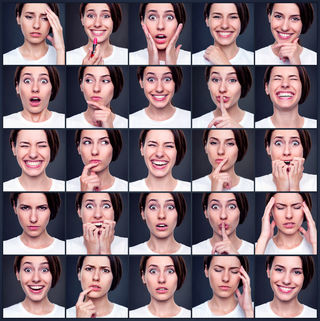Happiness
35 Facial Expressions That Convey Emotions Across Cultures
Of 35 facial expressions used to convey emotions, 17 convey happiness.
Posted January 16, 2019

Do you find it difficult to choose the perfect smiley-face emoji when trying to convey happy emotions in a text message? Although many emojis look very similar, it seems there are countless slightly different happy emoji faces. Which is the most popular? An analysis of text messages sent by Android and iOS devices found that "Face with Tears of Joy" was the most popular. In 2015, Oxford Dictionaries named it their official Word of the Year.
Interestingly, new cross-cultural research on how human faces convey emotions may explain why there are so many different smileys on every emoji board. Ohio State University researchers found that happiness is linked to significantly more real-world facial expressions used to convey various types of joy than facial expressions that convey sadness, disgust, anger, or fear.
This paper, “Cross-Cultural and Cultural-Specific Production and Perception of Facial Expressions of Emotion in the Wild,” by Ramprakash Srinivasan and Aleix Martinez, was recently published in the journal IEEE Transactions on Affective Computing.
Martinez is a professor in the department of Electrical and Computer Engineering at Ohio State. He's also founder and director of the Computational Biology and Cognitive Science Lab. Srinivasan is a doctoral student in Martinez’s lab. According to the authors, their latest paper (Srinivasan & Martinez, 2018) represents the first large-scale study based on visual perception of facial expressions representing various emotions outside the confines of a controlled laboratory setting.
At the onset of this study, Srinivasan et al. compiled a list of 821 English words that describe every imaginable feeling and then conducted a massive internet search that mined the internet for facial images corresponding to these words. Martinez’s lab enlisted bilingual professionals to translate all of the English words into Farsi, Mandarin, Russian, and Spanish. To avoid implicit or explicit bias, the researchers downloaded an equal number of images from the internet that corresponded with each word.
Srinivasan and Martinez analyzed more than 7 million images of candid facial expressions across a variety of cultures from 31 different countries based on snapshots and other real-world photos. The researchers did not include computer analysis from remote cultures or countries where they could only find a limited number of candid photographic images displaying indigenous facial expressions.

For their new study on facial expressions that occur "in the wild" (meaning outside a laboratory) Martinez and Srinivasan analyzed a dataset of approximately 7.2 million photographs of different facial expressions using advanced computer algorithms. Amazingly, they found that the human face is hypothetically capable of thousands and thousands of unique configurations, but only about three dozen expressions convey specific emotions across cultures. As the authors explained, "We find that of the 16,384 possible facial configurations that people can theoretically produce, only 35 are successfully used to transmit emotive information across cultures.”
The researchers were surprised to find that of innumerable possible configurations, only 35 facial expressions universally expressed different emotions across the cultures they studied. "We were shocked" only to find 35, Martinez said in a statement. "I thought there would be way, way more."
Of these 35 different facial expressions, Martinez and Srinivasan found that disgust is associated with one facial expression that is universally understood in every culture they examined. According to this study, humans use three different facial expressions to convey fear across cultures. The study also showed that we have four ways to convey surprise, five facial expressions for sadness, and five cross-cultural facial expressions that convey anger.
Facial expressions used to convey happiness were much more nuanced and abundant. Data analysis showed that people around the globe cross-culturally used 17 different facial expressions to convey feeling happy. "This was delightful to discover because it speaks to the complex nature of happiness,” Martinez said. “Happiness acts as a social glue and needs the complexity of different facial expressions; disgust is just that: disgust."
The main takeaway of this study is that humans have significantly more universal ways to express happiness than any other emotion. Notably, Homo sapiens appear to have evolved with 17 different facial expressions associated with happiness and only 18 expressions for all the other emotions we can convey across cultures.
References
Ramprakash Srinivasan and Aleix M. Martinez. "Cross-Cultural and Cultural-Specific Production and Perception of Facial Expressions of Emotion in the Wild." IEEE Transactions on Affective Computing (First published: December 18, 2018). DOI: 10.1109/TAFFC.2018.2887267


